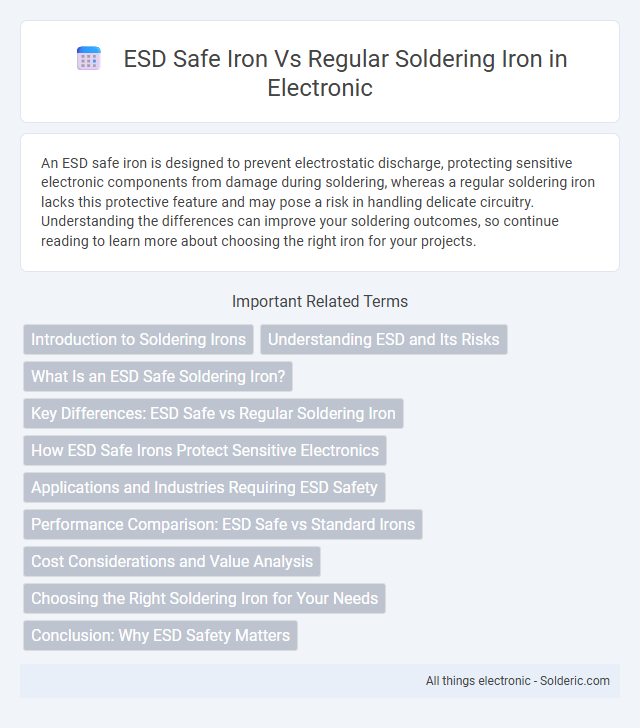An ESD safe iron is designed to prevent electrostatic discharge, protecting sensitive electronic components from damage during soldering, whereas a regular soldering iron lacks this protective feature and may pose a risk in handling delicate circuitry. Understanding the differences can improve your soldering outcomes, so continue reading to learn more about choosing the right iron for your projects.
Comparison Table
| Feature | ESD Safe Iron | Regular Soldering Iron |
|---|---|---|
| Purpose | Prevents electrostatic discharge damage | General soldering use |
| ESD Protection | Yes, built-in ESD protection | No ESD protection |
| Design | Insulated handle, grounded tip | Standard handle, ungrounded tip |
| Usage Environment | Electronics sensitive to static | Non-static sensitive applications |
| Price | Higher due to specialized features | Lower cost |
| Safety | Reduces risk of component damage | Higher risk of static damage |
| Maintenance | Requires regular grounding checks | Minimal maintenance |
Introduction to Soldering Irons
ESD safe irons are specifically designed to prevent electrostatic discharge, protecting sensitive electronic components during soldering processes. Regular soldering irons lack this protection and can cause damage to delicate circuits, making ESD safe irons essential for precision electronics work. Your choice between these tools should prioritize component safety and device reliability in sensitive applications.
Understanding ESD and Its Risks
Electrostatic Discharge (ESD) refers to the sudden flow of electricity between two electrically charged objects, which can irreparably damage sensitive electronic components during soldering. An ESD safe iron is designed with grounding features and static-dissipative materials to prevent static buildup, protecting delicate circuits from voltage spikes. Choosing an ESD safe iron ensures your soldering process minimizes component failure and enhances product reliability.
What Is an ESD Safe Soldering Iron?
An ESD safe soldering iron is specifically designed to prevent electrostatic discharge, protecting sensitive electronic components during soldering tasks. It features conductive materials and grounding mechanisms that dissipate static electricity safely, unlike regular soldering irons that lack these properties and can cause damage to delicate circuits. This makes ESD safe irons essential for working on static-sensitive electronics such as computer hardware and integrated circuits.
Key Differences: ESD Safe vs Regular Soldering Iron
ESD safe soldering irons feature grounded or static-dissipative materials that prevent electrostatic discharge damage, essential when working with sensitive electronic components. Regular soldering irons lack this protection, increasing the risk of static-related failures in delicate circuits. Temperature control and tip design may also differ, but the primary distinction lies in the ESD-safe construction ensuring safe handling of electrostatic-sensitive devices.
How ESD Safe Irons Protect Sensitive Electronics
ESD safe soldering irons incorporate built-in grounding elements and static-dissipative materials that prevent electrostatic discharge, which can damage sensitive electronic components during soldering. These irons maintain a controlled resistance path to ground, ensuring any static electricity is safely discharged away from delicate circuitry. Regular soldering irons lack these protective features, posing a higher risk of ESD-induced damage in precision electronic assembly and repair tasks.
Applications and Industries Requiring ESD Safety
ESD safe irons are essential in electronics manufacturing, telecommunications, and aerospace industries where preventing electrostatic discharge is critical to protect sensitive components. Regular soldering irons may pose a risk of static damage, making them unsuitable for handling integrated circuits, computer hardware, or medical devices. Your choice of an ESD safe iron ensures compliance with strict industry standards and safeguards delicate electronics during assembly and repair.
Performance Comparison: ESD Safe vs Standard Irons
ESD safe irons are designed with grounded components and antistatic materials to prevent electrostatic discharge, making them essential for sensitive electronic assemblies. Standard soldering irons lack these protective features, increasing the risk of damaging delicate components through static discharge. In terms of soldering performance, both types offer comparable temperature control and heating efficiency, but ESD safe irons provide critical protection without compromising precision or reliability.
Cost Considerations and Value Analysis
ESD safe irons typically cost 20-40% more than regular soldering irons due to specialized materials and built-in grounding features that prevent static discharge damage in sensitive electronics. The value of investing in an ESD safe soldering iron becomes evident in applications involving ESD-sensitive components, where the prevention of costly device failure outweighs the initial price difference. For general-purpose soldering, regular irons offer lower upfront costs but lack the protective benefits against electrostatic discharge-related damage.
Choosing the Right Soldering Iron for Your Needs
Selecting an ESD safe iron over a regular soldering iron is crucial for tasks involving sensitive electronic components to prevent electrostatic discharge damage. ESD safe irons feature grounded tips and anti-static handles that dissipate static electricity, ensuring protection for delicate circuits in devices like smartphones and computers. Regular soldering irons lack these protective measures, making them suitable only for non-static-sensitive applications or basic soldering tasks.
Conclusion: Why ESD Safety Matters
ESD safe irons protect sensitive electronic components from electrostatic discharge damage, which regular soldering irons do not guard against. Using an ESD safe iron minimizes the risk of invisible damage that can cause device failure or reduced performance over time. Investing in your tools ensures your electronics work reliably and extends their lifespan by preventing costly static-related repairs.
ESD safe iron vs regular soldering iron Infographic

 solderic.com
solderic.com